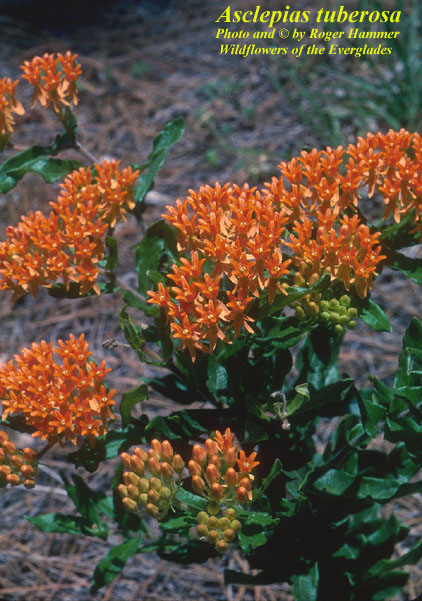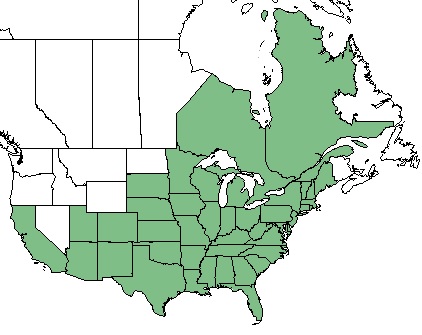Difference between revisions of "Asclepias tuberosa"
(→Pollination) |
|||
| Line 40: | Line 40: | ||
===Pollination=== | ===Pollination=== | ||
| − | This species is of special value to bumble bees, honey bees, and native bees and can attract butterflies and hummingbirds as well.<ref name="Ladybird"/> In Arizona, the most important pollinators for ''A. tuberosa'' were ''Bombus sonorus'', ''Apis mellifera'', and small-sized bees. However, the presence of pollinators and their dominance varied between each year of the two year study. Other pollinators observed include ''Battus philenor'', small-sized Lepidoptera (i.e. Hesperiidae, Nymphalidae, Pieridae), medium-sized Lepidoptera (i.e. Hesperiidae, Lycaenidae, Nymphalidae, Pieridae), medium sized bees (i.e. Anthophoridae, Megachilidae), and ''Archilochus alexandri''.<ref name="Fishbein & Venable 1996">Fishbein M, | + | This species is of special value to bumble bees, honey bees, and native bees and can attract butterflies and hummingbirds as well.<ref name="Ladybird"/> In Arizona, the most important pollinators for ''A. tuberosa'' were ''Bombus sonorus'', ''Apis mellifera'', and small-sized bees. However, the presence of pollinators and their dominance varied between each year of the two year study. Other pollinators observed include ''Battus philenor'', small-sized Lepidoptera (i.e. Hesperiidae, Nymphalidae, Pieridae), medium-sized Lepidoptera (i.e. Hesperiidae, Lycaenidae, Nymphalidae, Pieridae), medium sized bees (i.e. Anthophoridae, Megachilidae), and ''Archilochus alexandri''.<ref name="Fishbein & Venable 1996">Fishbein M, Venable DL (1996) Diversity and temporal change in the effective pollinators of ''Asclepias tuberosa''. Ecology 77(4):1061-1073.</ref> |
| − | |||
===Use by animals=== <!--Herbivory, granivory, insect hosting, etc.--> | ===Use by animals=== <!--Herbivory, granivory, insect hosting, etc.--> | ||
Revision as of 14:54, 13 February 2018
| Asclepias tuberosa | |
|---|---|

| |
| Photo by the Atlas of Florida Plants Database | |
| Scientific classification | |
| Kingdom: | Plantae |
| Division: | Magnoliophyta - Flowering plants |
| Class: | Magnoliopsida - Dicots |
| Order: | Gentianales |
| Family: | Asclepiadacea |
| Genus: | Asclepias |
| Species: | A. tuberosa |
| Binomial name | |
| Asclepias tuberosa (L) Brittonex Vail | |

| |
| Natural range of Asclepias tuberosa from USDA NRCS Plants Database. | |
Common Names: midwestern butterfly-weed; sandhills butterfly-weed; common butterfly-weed;[1] butterfly milkweed; Rolfs' milkweed;[2] orange milkweed; pleurisy root; chigger flower[3]
Contents
Taxonomic Notes
Varieties: A. tuberosa var. interior; A. tuberosa var. rolfsii; A. tuberosa var. tuberosa.[1] Other sources list these three varieties as subspecies.[2]
Synonyms: A. rolfsii; A. decumbens[1]
Description
Asclepias tuberosa is a dioecious perennial forb/herb.[2] It is bushy and grows to 30-60 cm in height. Leaves are alternate, pointed, smooth on the edge, and 1.50-2.25 in (3.81-5.72 cm) long. Flat-topped clusters 2-5 in (5.1-12.7 cm) diameter contain flowers,[3] which range from a yellow to yellowish orange or a deep-orange to reddish.[1][3] Each cluster contains 88-94 flowers when grown in Michigan, but 79-87 when brought into and grown in a greenhouse.[4] Despite its common name, milkweed, it has no milky sap.[3]
Distribution
This species is found from Quebec and Maine, westward to Ontario and Minnesota, southwestward to South Dakota, Colorado, Utah, Arizona, and California, and southward to central Texas, the Gulf Coast, and peninsular Florida.[2]
Ecology
Habitat
A. tuberosa occurs in dry forests, roadbanks, sandhills, woodland margins, roadsides, and pastures.[1]
Phenology
In the southeastern and mid-Atlantic United States, A. tuberosa flowers from May through September and fruits from August through September.[1] Daylengths and cold storage lengths interact to influence the number of shoots, flowers, and length of time it takes for A. tuberosa to reach market stage.[5]
Pollination
This species is of special value to bumble bees, honey bees, and native bees and can attract butterflies and hummingbirds as well.[3] In Arizona, the most important pollinators for A. tuberosa were Bombus sonorus, Apis mellifera, and small-sized bees. However, the presence of pollinators and their dominance varied between each year of the two year study. Other pollinators observed include Battus philenor, small-sized Lepidoptera (i.e. Hesperiidae, Nymphalidae, Pieridae), medium-sized Lepidoptera (i.e. Hesperiidae, Lycaenidae, Nymphalidae, Pieridae), medium sized bees (i.e. Anthophoridae, Megachilidae), and Archilochus alexandri.[6]
Use by animals
This species composes 2-5% of the diet of some large mammals and terrestrial birds.[7] Humans will often utilize this plant in home gardens because of its color and ability to attract butterflies. Native Americans also used to chew the root as a cure for pleurisy or other pulmonary ailments. However, consuming larger quantities of any part of the plant can be toxic.[3]
Conservation and Management
Cultivation and restoration
A. tuberosa can be propagated via seeds or root cuttings. Root propagation can be performed in the fall by cutting the taproot into 2 in (5.1 cm) sections and planting each section vertically while keeping the soil moist.[3]
Photo Gallery
References and notes
- ↑ 1.0 1.1 1.2 1.3 1.4 1.5 Weakley AS (2015) Flora of the Southern and Mid-Atlantic States. Chapel Hill, NC: University of North Carolina Herbarium.
- ↑ 2.0 2.1 2.2 2.3 USDA NRCS (2016) The PLANTS Database (http://plants.usda.gov, 13 February 2018). National Plant Data Team, Greensboro, NC 27401-4901 USA.
- ↑ 3.0 3.1 3.2 3.3 3.4 3.5 3.6 Plant database: Asclepias tuberosa. (13 February 2018) Lady Bird Johnson Wildflower Center. URL: https://www.wildflower.org/plants/result.php?id_plant=ASTU
- ↑ Albrecht ML, Lehmann JT (1991) Daylength, cold storage, and plant-production method influence growth and flowering of Asclepias tuberosa. HortScience 26(2):120-121.
- ↑ Cite error: Invalid
<ref>tag; no text was provided for refs namedAlbrecht & Lechmann 1991 - ↑ Fishbein M, Venable DL (1996) Diversity and temporal change in the effective pollinators of Asclepias tuberosa. Ecology 77(4):1061-1073.
- ↑ Miller JH, Miller KV (1999) Forest plants of the southeast and their wildlife uses. Southern Weed Science Society.